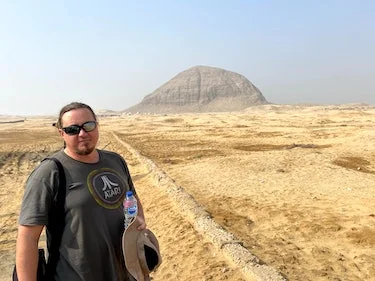
Jimmy Corsetti
Jimmy Corsetti is an American YouTuber, independent researcher, former theft/fraud investigator, and army/Iraq war veteran who makes videos related to ancient mysteries, conspiracies, and the cosmos, all while using his life experinece in this area. Corsetti joined YouTube on June 4, 2016, and is currently residing in the United States.

Ben van Kerkwyk
Ben van Kerkwyk is an Australian researcher, writer and content creator, now living in the United States. He runs the unchartedx.com website and associated youtube channel, and produces podcasts and short-form documentaries on various topics dealing with ancient mysteries and the new scientific work that has a bearing on the story of human history.
Books Mentioned on The Joe Rogan Experience (JRE) #1928 with Jimmy Corsetti & Ben Kerkwyk:
Exploring the Mystery of Atlantis: Insights from Joe Rogan Experience (JRE) #1928
The Joe Rogan Experience episode #1928 featured a fascinating discussion with Jimmy Corsetti and Ben van Kerkwyk, where they delved into the enigmatic topic of Atlantis. The focus was primarily on the Rashad Structure, a remarkable geological formation in the western Sahara Desert of Mauritania, also known as the “Eye of the Sahara”. This site, largely unknown to the general public, exhibits striking similarities to Plato’s description of the lost city of Atlantis, arousing curiosity and speculation about its true nature.
Geological and Historical Parallels with Atlantis
Corsetti, known for his YouTube channel “Bright Insight”, presented compelling evidence aligning the Rashad Structure with Plato’s Atlantis. This evidence includes:
- Concentric Circles: The structure’s layout of concentric circles of land and water closely resembles Plato’s description of Atlantis.
- Geographical Features: Features such as an opening to the south, mountains to the north, and the presence of red, black, and white color stones at the site echo Plato’s detailed account.
- Historical Ties: The first known king of Mauritania, where the Rashad Structure is located, was named Atlas, reminiscent of the first king of Atlantis.
- Natural Resources: Mauritania’s abundance of gold and historical richness, exemplified by figures like Mansa Musa, align with descriptions of Atlantis’s wealth.
The Sahara’s Transformation and Catastrophic Events
The discussion also highlighted the Sahara Desert’s drastic transformation over millennia. Around 4,500 to 5,000 years ago, what is now a vast desert was once a lush, green landscape with an extensive river network and a massive freshwater lake, Mega Lake Chad. This drastic environmental change raises questions about the possibility of a civilization like Atlantis existing in this region during a more hospitable era.
Geological Evidence Supporting the Atlantis Hypothesis
Corsetti shared significant geological findings, such as:
- Catastrophic Water Erosion: Evidence suggests that water erosion, potentially from the ocean, dramatically altered the Sahara landscape more recently than previously thought.
- Mount KUSI Observations: The largest volcano in Sahara Africa, Mount KUSI, shows signs of water erosion cutting through a lava flow dated around 12,000 years ago, challenging established geological timelines.
Correlations with Ancient Egyptian Origin Stories
Ben van Kerkwyk brought an interesting perspective by linking Plato’s tale to ancient Egyptian origin stories. He noted similarities between the aftermath of Atlantis, as described by Plato, and Egyptian tales of a primordial mound or island, suggesting possible cultural transmissions or shared mythologies between these ancient civilizations.
Final Thoughts
The Joe Rogan Experience #1928 offered a deep dive into the mystery of Atlantis, blending historical, geological, and mythological perspectives. While the true nature of the Rashad Structure and its connection to the Atlantis legend remains a subject of debate, the discussion undoubtedly opened new avenues for exploration and understanding of our ancient past.
Unraveling Ancient Mysteries: Joe Rogan Experience (JRE) #1928
In episode #1928 of the Joe Rogan Experience, Joe Rogan engages in a thought-provoking discussion with guests Jimmy Corsetti and Ben van Kerkwyk. The conversation revolves around the mysteries of ancient civilizations, particularly focusing on the age and construction techniques of the pyramids and other ancient structures worldwide.
Global Similarities in Ancient Construction
The episode opens with a fascinating insight into the similarities between construction methods across different ancient cultures. Rogan highlights the striking resemblance between sarcophagus covers found in Japan, Egypt, and other parts of the world, despite the supposed lack of connection between these ancient civilizations. The discussion emphasizes the complexity and intricacy of these constructions, often involving incredibly hard stones like granite and granodiorite.
Questioning the Age of the Pyramids
A significant portion of the conversation questions the established age of the pyramids. Rogan and his guests express skepticism about the commonly accepted timeline of 2500 BC for the construction of the Egyptian pyramids. They argue that the dating methods, largely based on organic matter found near the stones, might not accurately reflect the true age of these megalithic structures.
Advanced Technologies in Prehistoric Times
The episode delves into the possibility of advanced technologies existing in prehistoric times. The guests discuss artifacts like vases made from igneous stone, found beneath the Step Pyramid of Djoser, which date back to pre-dynastic times. They explore the idea that such precision and engineering, evident in these artifacts, hint at a level of technological advancement not typically associated with ancient civilizations.
The Role of Metrology in Understanding Ancient Artifacts
Corsetti and van Kerkwyk discuss recent efforts to apply modern metrology to ancient artifacts. They mention the work of Alex Dunn and Nick Sierra, who used structured light scanners to analyze pre-dynastic Egyptian vases. Their findings suggest that these vases, exhibiting astounding precision, were likely made using advanced machinery, challenging conventional beliefs about ancient manufacturing techniques.
Conclusion: Reevaluating Historical Perceptions
Joe Rogan Experience #1928 serves as a platform for reevaluating our understanding of ancient civilizations. The discussion encourages listeners to question the established narratives about the age and technological capabilities of these societies. By exploring the parallels in global ancient architecture and the evidence of advanced prehistoric technologies, the episode opens up new perspectives on the mysteries of our ancient past.





